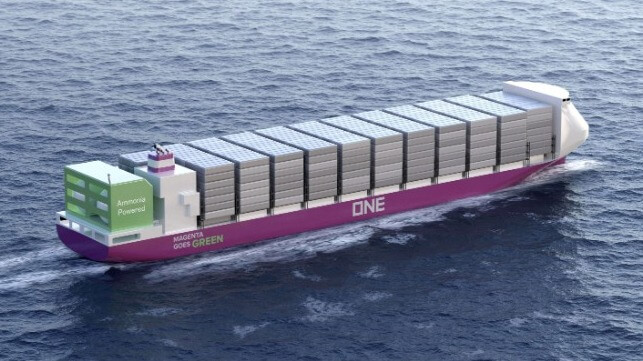ONE, Nihon and DNV Win Design Approval for Ammonia-Fueled Containership

Ocean Network Express (ONE) revealed that it is part of a project working to develop designs for an ammonia-fueled containership. The carrier is among the first to preview its ammonia plans while it is also proceeding with the construction of methanol dual-fuel vessels.
The project to study ammonia-fueled propulsion launched in late 2022 working with Nihon Shipyard and classification society DNV. ONE reports that it also participated in an ammonia bunkering pilot safety study led by the Global Centre for Maritime Decarbonisation (GCMD) in Singapore.
The project has reached a critical milestone with ONE announcing today that DNV awarded an Approval in Principle (AiP) for the ammonia dual-fuel vessel. Few details were revealed about the vessel other than it would have a 3,500 TEU capacity and was jointly developed by ONE, Nihon, and DNV.
“Ammonia is definitely one of the primary focuses of our research as ammonia fuel has a great potential of generating lower GHG emissions than conventional marine fuels,” said Koshiro Wake, Senior Vice President of Corporate Strategy & Sustainability Department at ONE. The company calls alternative fuels one of the key pillars of its green strategy saying it will continue to study alternative fuels.
The rendering released by Nihon Shipyard shows a few other critical elements likely specifically to address the challenges of ammonia. The vessel’s deckhouse and accommodations are moved to the front of the vessel providing the greatest possible distance from the fuel tanks and engine spaces. Like Maersk’s design for its new methanol dual-fuel ocean-going vessels, it would have a single funnel offset to one side, a concept that Maersk said will improve container handling and the capacity of the vessel.
“We are confident that DNV's rules for ammonia will help our customers to safely adopt this new fuel type once the infrastructure is in place,” said Cristina Saenz de Santa Maria, Regional Manager South East Asia, Pacific & India, Maritime at DNV. The IMO is still considering future rules for the use of ammonia as a marine fuel and how to address the challenges of toxicity of the gas.
DNV, for example, in its preliminary guidance calls for enclosing the tanks and placing them away from the hull and engine room to reduce the dangers. The rendering shows the tanks placed on the stern and enclosed with a steel structure around the tanks. A similar approach has been used for some vessels using LNG.
There are several challenges still to be overcome to make ammonia commercially viable. Starting ignition and maintaining consistent combustion is one of the key issues. Japanese engine makers have been studying combustion and reported last year achieving stable combustion while most tests use a small amount of traditional fuel in a blend, especially for ignition.
A similar study is also underway with shipowner Seaspan Corp. leading the design project for the vessel, working with the Maersk Mc-Kinney Moller Center, ABS, and design house Foreship. In May 2023 they presented their first concept for a 15,000 TEU containership and in a presentation discussed steps taken to overcome the challenges of using ammonia as a marine fuel.
Several shipping companies, however, have already moved forward with ordering and building ammonia-ready designs. The CMA CGM Masai Mara, a 77,000 dwt vessel with a capacity of 6,000 TEU, was delivered in May 2023 and billed as the first ammonia-ready container vessel. Ordered and owned by CMB (Compagnie Maritime Belge), the vessel was designed to be at the cutting edge of the industry reflecting the Saverys family's outlook.
Norway’s North Sea Container Line and ammonia-producer Yara International in November 2023 also detailed their plans to create an ammonia-fueled feeder vessel. They expect to place the vessel in service in the Baltic region in 2025.
